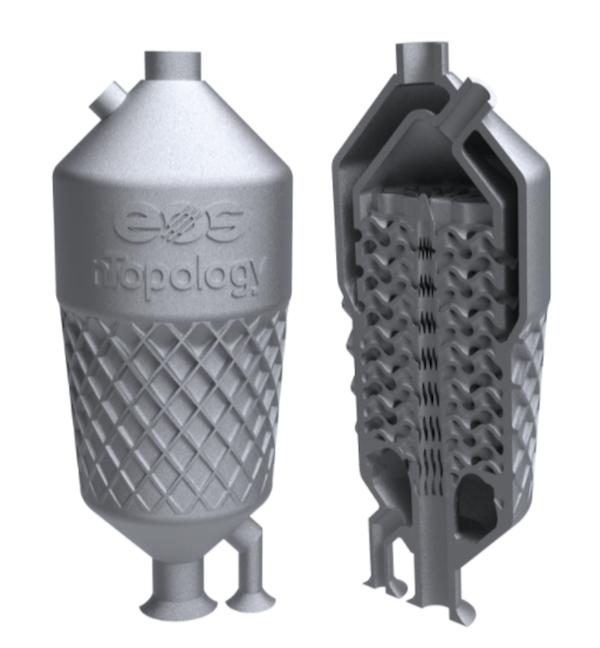The Importance of Lattice Structure in Design Engineering
Using lattices in your design structure can expand your design freedom and help create more economical products and designs.

Image courtesy of nTopology.
February 2, 2022
Design engineering and additive manufacturing processes allow you to reap the maximum capabilities of a lattice structure to enhance product performance.
Confused?
Before moving forward, let’s explore what lattice structure means.
Lattice structures are two- or three-dimensional micro-architectures made up of beams, struts, or nodes. They’re bio-inspired configurations composed of trusses with honeycomb and octagonal patterns. In nature, any lattice-like structure imparts strength and flexibility to otherwise a lightweight material.
Interestingly, in design engineering, usage of the lattice can help enhance the engineering model’s performance.
The latticing technique is slowly gaining traction because it can reduce the overall mass part by a whopping 90%. You can achieve more weight reduction if you tune your lattice parameters to the physical loads on the desired part.
Importance of Lattice Structures
Every lattice structure in design engineering has a unique characteristic, and they impart different properties in the object they’re used. Incorporating lattices allows design engineers to design spaces by re-thinking the desired performance level of an object or part. Apart from this, a lattice is an invention that comes in handy in the following situations:
1. Mechanical benefits
From modern architecture like the Eiffel Tower to nature (structure of bones), lattices are abundant. The metal structure of the Eiffel Tower supports the structure even when its weight reaches into the sky.
Surprised?
The high strength-to-weight ratio of a lattice structure made this tower a reality and gave the world one of the Seven Wonders of the World. The ability to provide impact protection, high surface area, and shock absorptions increases the popularity of these structures. Products created using a lattice can defy traditional manufacturing constraints and help create high-performing products at a reduced cost.
2. Provides excellent surface area
Lattices are lightweight structures because they can unlock a significant quantity of surface area. Due to this property, engineers incorporate lattice structures in heat exchangers widely used in data centers and computer servers.
As the amount of heat dissipated by a server affects the processor’s performance, design engineers look for different ways to remove excessive heat from the processor’s chip. They try to expel the heat generated using a fan.
But how does a lattice fit in this scenario?
The efficiency of the processor’s chip depends upon the heat sink’s surface area. Lattices can improve the heat sink’s surface area.
As a result, the processor’s chips take a lot of time to heat. Interestingly, this property comes in handy in different heat exchangers, where it’s nearly impossible to create small features with a large surface area.
3. Enhances shock absorption
Interestingly, lattices can prevent products from collisions and dropping by absorbing impact energy. Because of the excellent shock absorption power, lattices help create football and cricket helmets that can absorb many shocks.
With growing knowledge and application of lattices, designers use lattices in various electronic components to prevent them from breaking after an accidental fall. They effortlessly reduce the impact stress to protect the critical component of a product. In the coming years, lattices could revolutionize the smartphone and computer market.
4. Provides self-support and saves weight
Some lattices provide self-support features, which eliminate the need for a support structure that’s traditionally required in additive manufacturing. This helps in saving a lot of material.
What’s more interesting is that lattices can decimate weight without compromising on displacement and stress. As a result, design engineers widely use lattices in ballistic protection, lightweight structural panels, and porous implants.
5. Generates automatically in a CAD system
You no longer have to run from pillar to post to create these complex cells for your product. Some CAD systems include technologies that can quickly adapt these structures to your models. A design engineer specifies all properties of a cell, generates it and tests your results based on your design environment.
6. Reduces vibrations and noise dampening
Lattices help design engineers reduce potential mechanical noise, such as vibrations. Noises and vibrations in a machine can be uncomfortable for users and degrade the overall machine performance.
Lattice structures can reduce vibrations and noise dampening because of their ability to withstand and recover large strains. Interestingly, these structures offer low stiffness that further dampens vibration. Also, lattices allow engineers to refine designs that can match their application requirements.
Types of lattice structures
Lattice structures are essential across all industries, and there are three main types of structures:
1. Beam structure
It’s the most commonly used lattice with a triangular, square profile, and hexagonal cells. Design engineers use this beam structure with excellent damage tolerance because it helps to create lightweight and energy-absorbing structures.
2. Plate structure
The plate structure is a honeycomb-like structure with high directional stiffness. Plate-lattices are not just stiffer than their truss-lattices structures but are stronger in every aspect.
3. TPMS
TPMS is a surface-based lattice that comes in two different forms, known as skeletal and sheet-based surface lattices. Design engineers can use this TPMS lattice to design various engineering models like heat exchangers and use TPMS lattice in thermal management applications. Interestingly, by modifying the trigonometric equation, you can create an array of structures.
4. Stochastic structure
Stochastic is a strut-based lattice comprising rod-like forms connected using various orientations to create different lattice unit cells. When the cells are connected randomly throughout a structure, it’s called stochastic structure.
Interestingly, as this structure can match the properties of a human bone, a stochastic structure finds its application in the biomedical field. Also, a stochastic structure can quickly reconnect with bone structures inside the human body due to its properties.
5. Custom lattices
A custom lattice allows a design engineer to define their cells. It’s essential for anyone who wishes to experiment with the possibilities of a lattice. With a custom lattice, you can make changes with endurance, fatigue, and performance. You can model a custom lattice based on your imagination.
6. Homogeneous lattice structures
Such a structure has uniform properties across the structure, and properties like density, wall thickness, and unit cell size remain unchanged.
7. Heterogenous lattice structures
Contrary to a homogenous structure, design engineers can alter lattice properties in specific areas. In areas where you expect the stress to be high, you can increase the lattice density to impart strength in that area. It helps in making structures that can resist a lot of weight.
Why are lattices Commonly Used in Design Engineering?
What makes lattices popular and intriguing is their ability to form different structures. Another essential aspect of lattice in design engineering is how dramatically these structures can reduce weight while maintaining structural integrity. As a result, engineers have higher control over specific characteristics of structures they create.
What’s more interesting is that lattices provide a visual appeal to objects of architecture such as buildings, furniture, towers, and ceilings. Design engineers widely use these structures in batteries and heat exchangers or other areas that require optimal energy transmission.
Design Tips for Working with Lattice Structures in 3D Printing
Before 3D printing, lattices were rarely used in additive manufacturing and design engineering. Nowadays, design engineers are trying to implement lattices in soft robotics and understand pulmonary airway functions. With 3D printing, companies can produce lattice structures in saddles, shoes, helmets, nasal swabs, and other designs. So, before developing lattice structures in 3D printing, keep the following design tips in mind:
Knowing about additive manufacturing and design engineering principles is essential for creating innovative designs. Before commencing a lattice structure design, ensure that you can develop a structure on the additive system. This is essential because if product manufacturing fails, it can result in many failed parts.
So, understand what an additive system can do before deciding to use lattice structuring.
Another thing to keep in mind is to ensure that a lattice structure is small, clustered, and densely packed together. Such designs can slow down your 3D printing process, which can eventually reduce your project’s economics.
Also, keep in mind that every printer has a resolution, so don’t design a lattice structure smaller than the pixel size and resolution of the printer.
Wrapping Up
Using lattices in your design structure can explode your design freedom and help you create economical products and designs with the required characteristics.
Today, companies looking to impact and make a name in their respective field should strive to include lattice structures in a design to open up the doors for new applications.
If you’ve never designed lattices before, it’s a great idea to tap an expert like nTopology to help you get started.
How are you using lattice structures in additive manufacturing and design engineering? Please share your thoughts with us.
Priya Jain is a professional copywriter with 8 years of experience. She has an MBA and engineering degree. When she is not writing, you will find her teaching math, spending her day running behind her toddler, and trying new recipes. You can follow her on LinkedIn.
Subscribe to our FREE magazine, FREE email newsletters or both!






